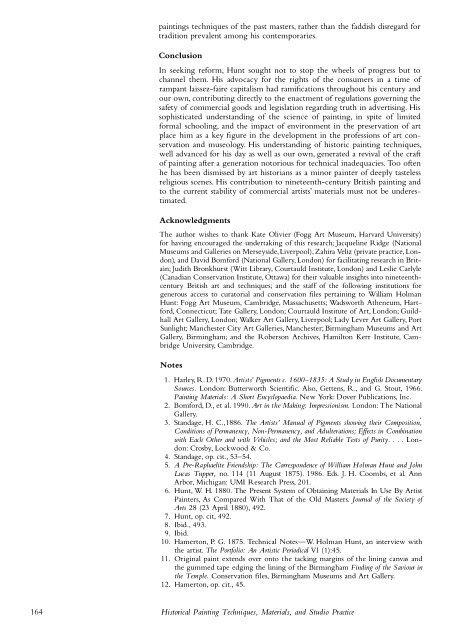Historical Painting Techniques, Materials, and Studio Practice
Create successful ePaper yourself
Turn your PDF publications into a flip-book with our unique Google optimized e-Paper software.
paintings techniques of the past masters, rather than the faddish disregard for<br />
tradition prevalent among his contemporaries.<br />
Conclusion<br />
In seeking reform, Hunt sought not to stop the wheels of progress but to<br />
channel them. His advocacy for the rights of the consumers in a time of<br />
rampant laissez-faire capitalism had ramifications throughout his century <strong>and</strong><br />
our own, contributing directly to the enactment of regulations governing the<br />
safety of commercial goods <strong>and</strong> legislation regarding truth in advertising. His<br />
sophisticated underst<strong>and</strong>ing of the science of painting, in spite of limited<br />
formal schooling, <strong>and</strong> the impact of environment in the preservation of art<br />
place him as a key figure in the development in the professions of art conservation<br />
<strong>and</strong> museology. His underst<strong>and</strong>ing of historic painting techniques,<br />
well advanced fo r his day as well as our own, generated a revival of the craft<br />
of painting after a generation notorious for technical inadequacies. Too often<br />
he has been dismissed by art historians as a minor painter of deeply tasteless<br />
religious scenes. His contribution to nineteenth-century British painting <strong>and</strong><br />
to the current stability of commercial artists' materials must not be underestimated.<br />
Acknowledgments<br />
The author wishes to thank Kate Olivier (Fogg Art Museum, Harvard University)<br />
for having encouraged the undertaking of this research; Jacqueline Ridge (National<br />
Museums <strong>and</strong> Galleries on Merseyside, Liverpool), Zahira Veliz (private practice, London),<br />
<strong>and</strong> David Bomford (National Gallery, London) fo r facilitating research in Britain;Judith<br />
Bronkhurst (Witt Library, Courtauld Institute, London) <strong>and</strong> Leslie Carlyle<br />
(Canadian Conservation Institute, Ottawa) for their valuable insights into nineteenthcentury<br />
British art <strong>and</strong> techniques; <strong>and</strong> the staff of the following institutions fo r<br />
generous access to curatorial <strong>and</strong> conservation files pertaining to William Holman<br />
Hunt: Fogg Art Museum, Cambridge, Massachusetts; Wadsworth Atheneum, Hartfo<br />
rd, Connecticut; Tate Gallery, London; Courtauld Institute of Art, London; Guildhall<br />
Art Gallery, London; Walker Art Gallery, Liverpool; Lady Lever Art Gallery, Port<br />
Sunlight; Manchester City Art Galleries, Manchester; Birmingham Museums <strong>and</strong> Art<br />
Gallery, Birmingham; <strong>and</strong> the Roberson Archives, Hamilton Kerr Institute, Cambridge<br />
University, Cambridge.<br />
Notes<br />
1. Harley, R. D. 1970. Artists' Pigments c. 1600-1835: A Study in English Documentary<br />
Sources. London: Butterworth Scientific. Also, Gettens, R., <strong>and</strong> G. Stout, 1966.<br />
<strong>Painting</strong> <strong>Materials</strong>: A Short Encyclopaedia. New York: Dover Publications, Inc.<br />
2. Bomford, D., et al. 1990. Art in the Making: Impressionism. London: The National<br />
Gallery.<br />
3. St<strong>and</strong>age, H. C.,1886. The Artists' Manual of Pigments showing their Composition:<br />
Conditions of Permanency, Non-Permanency, <strong>and</strong> Adulterations; Effects in Combination<br />
with Each Other <strong>and</strong> with Vehicles; <strong>and</strong> the Most Reliable Tests of Purity . .. . London:<br />
Crosby, Lockwood & Co.<br />
4. St<strong>and</strong>age, op. cit., 53-54.<br />
5. A Pre-Raphaelite Friendship: The Correspondence of William Holman Hunt <strong>and</strong> John<br />
Lucas Tupper, no. 114 (11 August 1875). 1986. Eds. J. H. Coombs, et al. Ann<br />
Arbor, Michigan: UMI Research Press, 20l.<br />
6. Hunt, W H. 1880. The Present System of Obtaining <strong>Materials</strong> In Use By Artist<br />
Painters, As Compared With That of the Old Masters. Journal of the Society of<br />
Arts 28 (23 April 1880), 492.<br />
7. Hunt, op. cit, 492.<br />
8. Ibid., 493.<br />
9. Ibid.<br />
10. Hamerton, P. G. 1875. Technical Notes-W Holman Hunt, an interview with<br />
the artist. The Porifolio: An Artistic Periodical VI (1):45.<br />
11. Original paint extends over onto the tacking margins of the lining canvas <strong>and</strong><br />
the gummed tape edging the lining of the Birmingham Finding of the Saviour in<br />
the Temple. Conservation files, Birmingham Museums <strong>and</strong> Art Gallery.<br />
12. Hamerton, op. cit., 45.<br />
164<br />
<strong>Historical</strong> <strong>Painting</strong> <strong>Techniques</strong>, <strong>Materials</strong>, <strong>and</strong> <strong>Studio</strong> <strong>Practice</strong>


